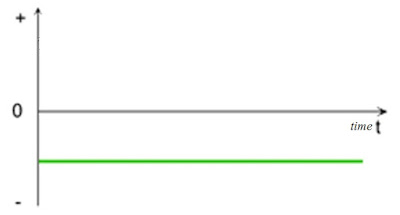மின்சாரம் என்றால் என்ன??
ஒரு கடத்தியில் அணுக்கள் நகர்ந்தால் அதில் மின்சாரம் பாய்கிறது என்கிறோம். அந்த அணுக்கள் நகர்வதற்கு மின்னழுத்தம் தேவை. மின்னழுத்தம் உருவாக்க கடத்தியின் இரு முனையிலும் திறல் வேறுபாடு (potential difference) வேண்டும், அதாவது கடத்தியின் ஒரு முனையில் இருக்கும் திறல் (potential) மற்றொரு முனையைவிட அதிகமாகவோ குறைவாகவோ இருந்தால் அதில் மின்னழுத்தம் உருவாகும். ஆதலால் மின்சாரமும் பாயும்.
மின்சாரம் பாயும் திசையினை பற்றி புரிந்து கொள்வதற்கு, ஒரு சிறிய எடுத்துக்காட்டை பார்ப்போம்.
அணுக்கள் அதிக திரலில் (high potential) இருந்து குறைந்த திரலை (low potential) நோக்கி நகரும். (அல்லது) அணுக்கள் எண்ணிக்கை அதிகமாக இருக்கும் இடத்தில இருந்து குறைவாக இருக்கும் இடத்தை நோக்கி நகரும்.
மேலுள்ள படத்தில் 1-ல் அதிக திறலும், 2-ல் 1-ஐ விட குறைவான திறலும் உள்ளது. அதனால் அந்த கடத்தியின் இரு முனையிலும் திறல் வேறுபாடு இருக்கிறது. அந்த திறல் வேறுபாடானது ஒரு மின்னழுத்தத்தை உருவாக்குகிறது. அதன்மூலம் அணுக்கள் திறல் அதிகமுள்ள 1-ல் இருந்து திறல் குவாக உள்ள 2-ஐ நோக்கி நகர்கிறது. எனவே மின்சாரத்தின் பாயும் திசை 1-ல் இருந்து 2-ஐ நோக்கி உள்ளது.
குறிப்பு: திறல் வேறுபாடும் மின்னழுத்தமும் கிட்டத்தட்ட ஒன்றுதான்.
மேலுள்ள படத்தில் 2-ல் அதிக திறலும், 1-ல் 2-ஐ விட குறைவான திறலும் உள்ளது. அந்த திறல் வேறுபாட்டால் அனுக்களானது 2-ல் இருந்து 1-ஐ நோக்கி நகர்கிறது. எனவே மின்சாரத்தின் பாயும் திசை 2-ல் இருந்து 1-ஐ நோக்கி உள்ளது.
மின்சார வகை:
1) மாறுதிசை மின்னோட்டம்- AC(Alternating Current)
2) ஒருதிசை மின்னோட்டம்- DC( Direct Current)
மாறுதிசை மின்னோட்டம்:
பெயரில் உள்ளவாறே இவ்வகை மின்சாரத்தின் மின்னோட்டம் (மின்சாரத்தின் திசை) மாறிக்கொண்டே இருக்கும். ஒரு வினாடிக்கு எத்தனை முறை மின்னோட்டம் மாறுகிறது என்பதையே அலைவெண் (frequency) என்கிறோம்.
மாறுதிசை மின்னோட்டம் உருவாக மாறுமின்னாக்கி (Alternator) பயன்படுகிறது.
ஒருதிசை மின்னோட்டம்:
பெயரில் உள்ளவாறே இவ்வகை மின்சாரத்தின் மின்னோட்டம் ஏதேனும் ஒரு திசையில் மட்டுமே இருக்கும்.
ஒருதிசை மின்னோட்டம் உருவாக மின்கலம் (battery), சூரியப்பலகம் (Solar panel), பல ரசாயன முறைகள்(chemical reaction), வெப்பமின் விளைவு முறை(thermo electric effect), இன்னும் பல முறைகள் பயன்படுகிறது.

ஒரு கடத்தியில் அணுக்கள் நகர்ந்தால் அதில் மின்சாரம் பாய்கிறது என்கிறோம். அந்த அணுக்கள் நகர்வதற்கு மின்னழுத்தம் தேவை. மின்னழுத்தம் உருவாக்க கடத்தியின் இரு முனையிலும் திறல் வேறுபாடு (potential difference) வேண்டும், அதாவது கடத்தியின் ஒரு முனையில் இருக்கும் திறல் (potential) மற்றொரு முனையைவிட அதிகமாகவோ குறைவாகவோ இருந்தால் அதில் மின்னழுத்தம் உருவாகும். ஆதலால் மின்சாரமும் பாயும்.
மின்சாரம் பாயும் திசையினை பற்றி புரிந்து கொள்வதற்கு, ஒரு சிறிய எடுத்துக்காட்டை பார்ப்போம்.
அணுக்கள் அதிக திரலில் (high potential) இருந்து குறைந்த திரலை (low potential) நோக்கி நகரும். (அல்லது) அணுக்கள் எண்ணிக்கை அதிகமாக இருக்கும் இடத்தில இருந்து குறைவாக இருக்கும் இடத்தை நோக்கி நகரும்.
மேலுள்ள படத்தில் 1-ல் அதிக திறலும், 2-ல் 1-ஐ விட குறைவான திறலும் உள்ளது. அதனால் அந்த கடத்தியின் இரு முனையிலும் திறல் வேறுபாடு இருக்கிறது. அந்த திறல் வேறுபாடானது ஒரு மின்னழுத்தத்தை உருவாக்குகிறது. அதன்மூலம் அணுக்கள் திறல் அதிகமுள்ள 1-ல் இருந்து திறல் குவாக உள்ள 2-ஐ நோக்கி நகர்கிறது. எனவே மின்சாரத்தின் பாயும் திசை 1-ல் இருந்து 2-ஐ நோக்கி உள்ளது.
குறிப்பு: திறல் வேறுபாடும் மின்னழுத்தமும் கிட்டத்தட்ட ஒன்றுதான்.
மேலுள்ள படத்தில் 2-ல் அதிக திறலும், 1-ல் 2-ஐ விட குறைவான திறலும் உள்ளது. அந்த திறல் வேறுபாட்டால் அனுக்களானது 2-ல் இருந்து 1-ஐ நோக்கி நகர்கிறது. எனவே மின்சாரத்தின் பாயும் திசை 2-ல் இருந்து 1-ஐ நோக்கி உள்ளது.
மின்சார வகை:
1) மாறுதிசை மின்னோட்டம்- AC(Alternating Current)
2) ஒருதிசை மின்னோட்டம்- DC( Direct Current)
மாறுதிசை மின்னோட்டம்:
பெயரில் உள்ளவாறே இவ்வகை மின்சாரத்தின் மின்னோட்டம் (மின்சாரத்தின் திசை) மாறிக்கொண்டே இருக்கும். ஒரு வினாடிக்கு எத்தனை முறை மின்னோட்டம் மாறுகிறது என்பதையே அலைவெண் (frequency) என்கிறோம்.
மாறுதிசை மின்னோட்டம் உருவாக மாறுமின்னாக்கி (Alternator) பயன்படுகிறது.
ஒருதிசை மின்னோட்டம்:
பெயரில் உள்ளவாறே இவ்வகை மின்சாரத்தின் மின்னோட்டம் ஏதேனும் ஒரு திசையில் மட்டுமே இருக்கும்.
ஒருதிசை மின்னோட்டம் உருவாக மின்கலம் (battery), சூரியப்பலகம் (Solar panel), பல ரசாயன முறைகள்(chemical reaction), வெப்பமின் விளைவு முறை(thermo electric effect), இன்னும் பல முறைகள் பயன்படுகிறது.

























